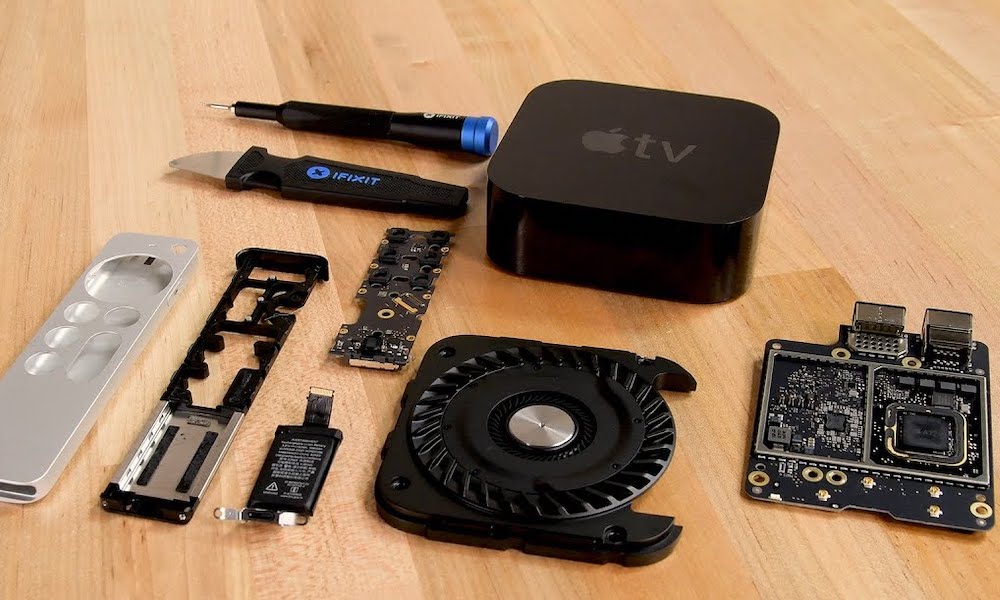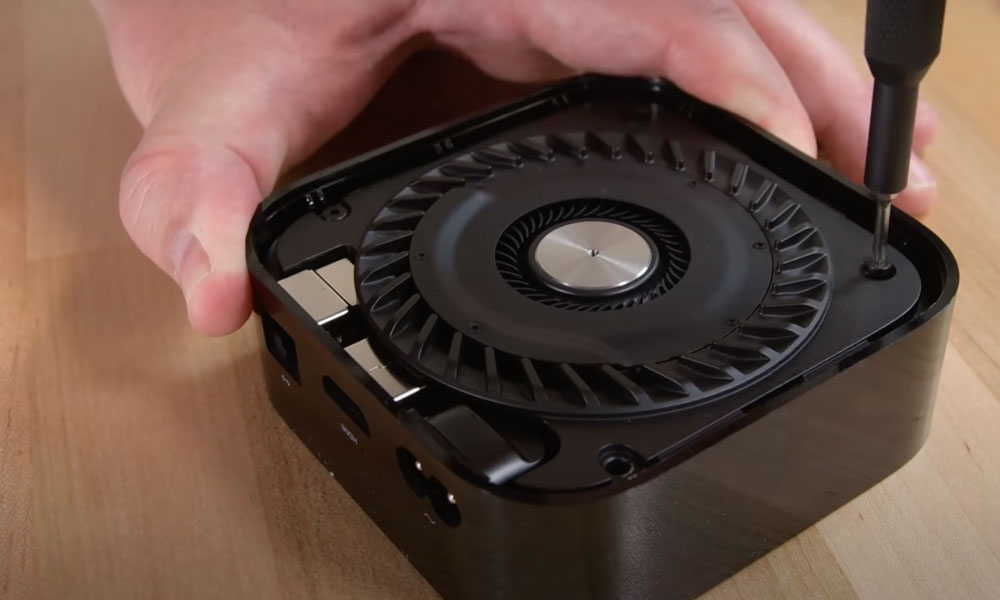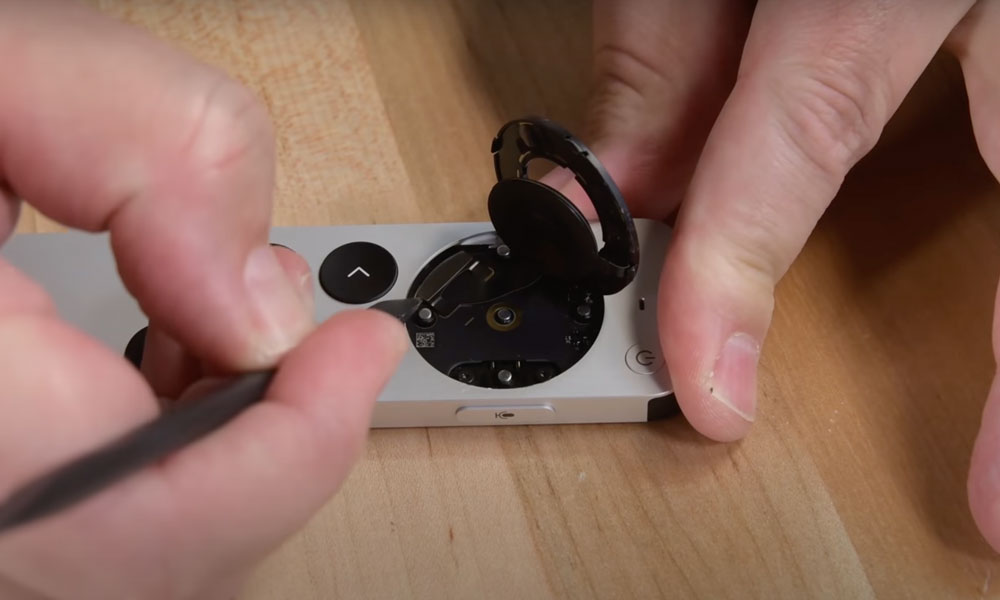iFixit Says the New Apple TV 4K Is Very Easy to Repair, But the New Siri Remote Is Less So
 Credit: iFixit
Credit: iFixitToggle Dark Mode
As usual, iFixit has wasted no time starting its teardown of the new Apple TV 4K, and it’s offering some interesting insights on what you’ll find on the insides of Apple’s newest set-top box.
Since the design of the Apple TV has remained basically unchanged for the past ten years, the process of opening it is still pretty straightforward. Some clips hold down the bottom panel which easily pops off, revealing the same sort of large fan found on the 2017 Apple TV 4K — the first time a fan had appeared in an Apple TV since the original 2007 models, which also packed in a hard drive in those days.
The fan unscrews easily enough, and iFixit was surprised to discover that instead of a cable connecting the fan to the logic board, power is transferred via a set of metal contact pins on the heatsink. The logic board is secured by a few additional torque screws and a few antenna cables.
Once opened up, the A12 Bionic processor can clearly be seen on the logic board, which iFixit identifies as the same chip found in Apple’s 2019 iPhone XS and iPhone XR models.
Underneath the logic board, all that remains is the large heatsink and a power supply, resulting in what iFixit calls “a super easy disassembly experience overall.”
Note, however, that while iFixit demonstrates that the casing of the new Apple TV is IR-transparent from any angle, there is one slightly misleading comment near the beginning of the video when the narrator adds that the IR-transparent casing means “you won’t have to worry about having perfect aim with that new remote.”
Like its predecessor, the new Siri Remote communicates with the Apple TV via Bluetooth, so it’s not necessary to aim it at the Apple TV at all. The IR port included on the Siri Remote is there only for controlling other devices that do require IR communications, such as volume and power on a connected TV set or AV receiver, and even then it’s only needed when those devices can’t be controlled over HDMI-CEC.
Along the same lines, the Apple TV 4K does still include an IR receiver to allow third-party remotes to be used with the set-top box, and in this case, iFixit is somewhat correct that the IR-transparent casing makes it easier to receive signals from these remotes. This is presumably located somewhere on the main logic board, although iFixit’s teardown video doesn’t give us a good indication of where that might be.
The Siri Remote
Unfortunately, as easy as the Apple TV 4K is to disassemble, the Siri Remote turns out to be another story entirely.
Disassembling the Siri Remote seemed easy enough at first glance, with two pentalobe screws beside the lightning port on the bottom of the remote, however it turns out these two screws only hold the bottom plate in place, and iFixit found there was nothing else to do on that end once the plate was removed.
So, iFixit takes the next step of popping off the buttons on the front of the remote, which required a fair bit of brute force. Of course, this isn’t a bad thing for end-users as you don’t likely want the buttons coming off too easily during normal use.
Underneath the buttons are three more torque screws to release the logic board and the Siri button on the side, which lifts out by itself. Once these screws have been loosened, the innards of the remote can be slid out of the aluminum casing via the black cap at the top end.
A plastic frame holds the logic board on the top end, secured by several more screws, while the rechargeable battery takes up the bottom third, glued in place, but removable without too much trouble.
iFixit identified the battery as a tiny 1.52Wh, but adds that it comes out with the Lightning port attached and soldered to the battery, which it notes will complicate battery replacement.
The new Apple TV 4K shares the same 8/10 repairability score as its predecessor, noting that it’s a simple modular design that uses standard screws and comes apart effortlessly.
However, iFixit is considerably less generous when it comes to the Siri Remote, nothing that it’s “overly complicated” to replace the battery.
To replace the battery — something everyone will have to do at some point — you’ll need to completely disassemble the remote; a process that is overly complicated and will scar the beautiful aluminum housing if you’re not careful.
iFixit
Although we can’t argue with iFixit about how tricky it is to get the new Siri Remote apart, we do disagree that it’s nearly as necessary as they claim. The idea that “everyone will have to [replace the battery] at some point,” strikes us as particularly unlikely, since the original Siri Remote uses so little power that users only need to charge it two or three times per year. There’s no reason to believe the second-generation Siri Remote will need to be charged any more often.
If the lithium-ion rechargeable battery inside the Siri Remote is rated for even one-tenth of the charge cycles that the iPhone battery is (50 vs 500), this would still allow even the heaviest Siri Remote users to get more than ten years of use before the internal rechargeable cell is even close to wearing out.
iFixit’s answer to this is the suggestion that Apple should move to a replaceable coin cell battery instead, similar to the AirTag. Still, the AirTag serves a very different purpose for which a rechargeable battery is very poorly suited — after all, who wants to worry about recharging their keychain a couple of times a year. In the case of the Siri Remote, however, the use of a rechargeable battery makes a lot more sense, and it’s better for the environment too.
While it’s certainly possible you could encounter a Siri Remote with a defective battery, these kinds of problems are much more likely to be encountered while the Siri Remote is still under warranty. Further, AppleCare+ for Apple TV costs $29 and extends that coverage for up to three years.









